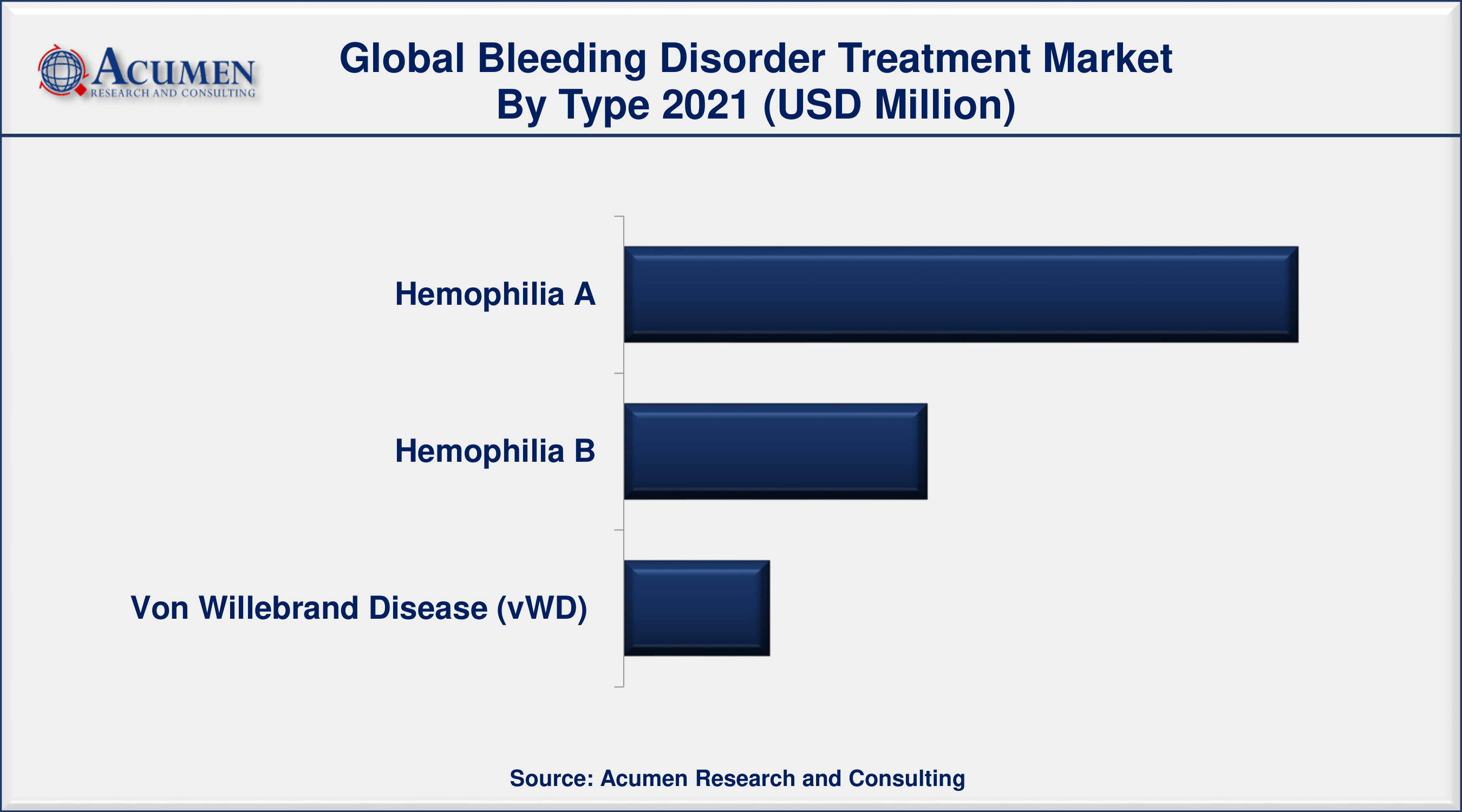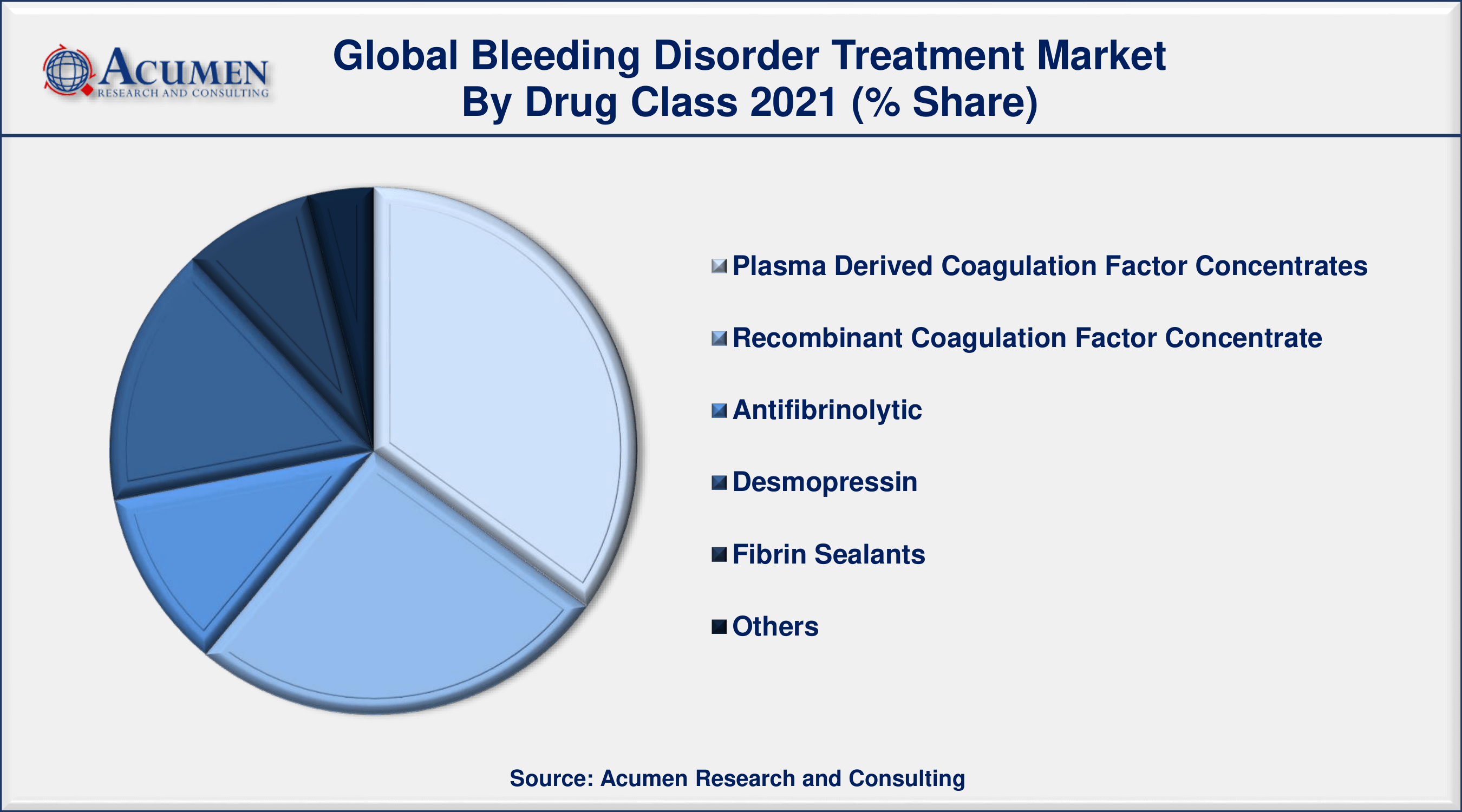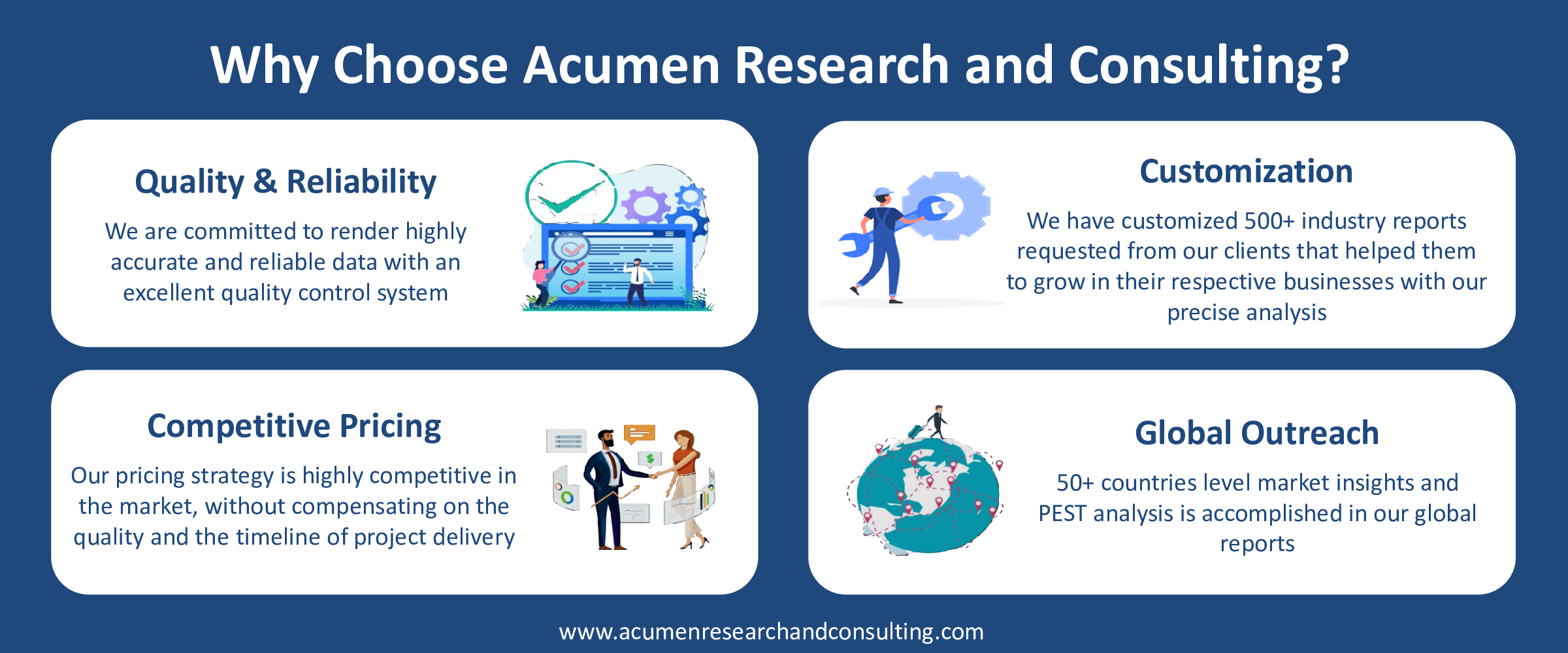Bleeding Disorder Treatment Market | Acumen Research and Consulting
Bleeding Disorder Treatment Market Size - Global Industry, Share, Analysis, Trends and Forecast 2022 - 2030
Published :
Report ID:
Pages :
Format :
The Global bleeding disorder treatment Market Size accounted for USD 13,570 Million in 2021 and is estimated to achieve a market size of USD 26,177 Million by 2030 growing at a CAGR of 7.8% from 2022 to 2030. The increase in the prevalence of hemophilia, technological advancement in diagnosis, and favorable government treatment initiatives are driving the growth of the bleeding disorder treatment market share. Furthermore, the rising prevalence of various blood disorders, as well as increased investment in R&D for advanced medical interventions, are significant driving factors in the bleeding disorder treatment market growth.

Bleeding Disorder Treatment Market Report Key Highlights
- Global bleeding disorder treatment market value is estimated to expand by USD 26,177 million by 2030, with a 7.8% CAGR from 2022 to 2030
- According to the World Federation of Hemophilia Report, approximately 315,423 people worldwide were affected by bleeding disorders in 2017
- North America bleeding disorder treatment market accounting for nearly 34% of the total market share in 2021
- According to the study, approximately 18 thousand people in the United States have haemophilia and over 11 thousand have von Willebrand disease
- Among type, hemophilia A segment held market share of over 60% in 2021
- Rise in the number of patients with von Willebrand disease, drives the bleeding disorder treatment market trend
The term "bleeding disorders" refers to a category of problems that occur when the blood does not clot properly. While it is relatively rare, hemophilia is probably the most well-known hereditary bleeding condition. Males are particularly affected by this condition. Furthermore, many suffer from von Willebrand disease, the most common hereditary bleeding condition in the US that is caused by clotting proteins. Both men and women are susceptible to the disease. The most common cause of bleeding disorders is platelet deficiency, which is commonly acquired rather than hereditary. According to the National Hemophilia Foundation, there are 30,000-33,000 individuals in the US who have hemophilia.
Global Bleeding Disorder Treatment Market Dynamics
Market Drivers
- Increasing R&D investment in hemophilia product development
- Increasing number of individuals with hemophilia diagnoses
- Growing preference for prophylactic diagnosis
- Rising healthcare expenditure
Market Restraints
- Rising cost of hemophilia drugs
- Insufficient reimbursement for treatment
Market Opportunities
- Rising disposable income and better healthcare infrastructure in emerging economies
- Growing biosimilar products market
Bleeding Disorder Treatment Market Report Coverage
| Market | Bleeding Disorder Treatment Market |
| Bleeding Disorder Treatment Market Size 2021 | USD 13,570 Million |
| Bleeding Disorder Treatment Market Forecast 2030 | USD 26,177 Million |
| Bleeding Disorder Treatment Market CAGR During 2022 - 2030 | 7.8% |
| Bleeding Disorder Treatment Market Analysis Period | 2018 - 2030 |
| Bleeding Disorder Treatment Market Base Year | 2021 |
| Bleeding Disorder Treatment Market Forecast Data | 2022 - 2030 |
| Segments Covered | By Type, By Drug Class, And By Geography |
| Regional Scope | North America, Europe, Asia Pacific, Latin America, and Middle East & Africa |
| Key Companies Profiled | Sanofi SA, Swedish Orphan Biovitrum AB, Janssen Pharmaceuticals, Inc., Baxter International Inc., Pfizer Inc., Genentech, Inc., CSL Behring, and Novo Nordisk |
| Report Coverage |
Market Trends, Drivers, Restraints, Competitive Analysis, Player Profiling, Regulation Analysis |
Big Calls For "Replacement Therapy"
Replacement therapy is the most common treatment for bleeding disorders. To avoid bleeding, patients may seek replacement therapy on a regular basis. This is known as prophylactic (PRO-fih-lac-tik) or preventive (PRO-fih-lac-tik) therapy. This replacement therapy can be provided to combat a bleeding episode that is in the progression stage, according to the Mayo Foundation for Medical Education and Research (MFMER). The use of "Antifibrinolytic Medicines" is yet another treatment option for bleeding disorders. Replacement therapy can be combined with antifibrinolytic medications (such as "tranexamic acid" and "epsilon aminocaproic acid"). It is given in the form of a tablet, which helps to prevent blood clots from breaking down. In the global bleeding disorder treatment market, replacement therapy with clotting factor replacement has also gained a lot of attention. Clotting factor replacement therapy can treat or avoid bleeding episodes by avoiding excessive blood loss and complications associated with bleeding, such as muscle, joint, and organ injury.
Research And Development Activities Bolster The Growth Of The Global Bleeding Disorder Treatment Market
Gene therapy aims to provide long-term expression of a missing or abnormal coagulation factor at adequate and consistent levels, reducing or even eliminating the need for exogenous factor replacement. A recombinant adeno-associated virus (rAAV) vector to deliver the coagulation factor gene to the patient's liver has gained strong attention. Apart from that, the National Hemophilia Foundation reports that gene therapy has been one of the most sought-after therapies for hemophilia for decades. Replacement of a faulty gene with a functional one to generate enough clotting factor to short-circuit bleeds in a one-shot operation that could repair the hereditary disease as its source. Several companies plan to obtain US Food and Drug Administration (USFDA) approval to sell gene therapy in the coming years, as the procedure has gained considerable interest in the global market.
Government In Alliance With Prominent Players Assists In Treatment Of Bleeding Disorders In Patients
The World Federation of Hemophilia (WFH) advocates for patients with hemophilia and von Willebrand disease (VWD), as well as women with bleeding disorders. The WFH Humanitarian Aid Program aims to improve access to care and treatment for people with hereditary bleeding disorders in developing countries by providing much-needed assistance. The WFH Humanitarian Aid Program ensures that patients have secure and timely access to treatment and care by providing a more stable and sustainable flow of humanitarian aid donations. It boosts future development by forming an alliance with influential players such as Sanofi, Genzyme, Sobi, Grifols and Roche, CSL Behring, and Bayer.
Bleeding Disorder Treatment Market Segmentation
The worldwide bleeding disorder treatment market segmentation is based on the type, drug class, and geography.
Bleeding Disorder Treatment Market By Type
- Hemophilia A
- Hemophilia B
- Von Willebrand Disease (vWD)

According to the bleeding disorder treatment industry analysis, the hemophilia A segment will dominate the global market during the forecast period. The rising prevalence of bleeding disorders and increasing severity with the genetic evolution worldwide is expected to drive the bleeding disorder treatment market globally. Hemophilia A affects 12 per 100,000 males in the United States, according to the Centers for Disease Control and Prevention (CDC). Every year, approximately 400 boys are born with Hemophilia A. Apart from that, the availability of many treatment options in the global market contributes to the growth of the bleeding disorder treatment market.
According to the data revealed by the National Hemophilia Foundation, the main medication to treat hemophilia A is a concentrated FV111 product, called clotting factor or simply factor. While plasma-derived FV111 products are still available, approx 75% of the hemophilia community takes a recombinant FV111 product.
Bleeding Disorder Treatment Market By Drug Class
- Plasma Derived Coagulation Factor Concentrates
- Recombinant Coagulation Factor Concentrate
- Antifibrinolytic
- Desmopressin
- Fibrin Sealants
- Others

According to the bleeding disorder treatment market forecast, the recombinant coagulation factor concentrates segment will record a remarkable share of the growth of the global bleeding disorder treatment market. As per the data revealed by the Food and Drug Administration (FDA), recombinant coagulation factor concentrates control of bleeding in patients aged 12 years and older with hemophilia A or B with inhibitors. In May 2020, FDA approved Coagulation Factor VIIa (Recombinant)-jncw for Hemophilia. The approval is based on data from a clinical study evaluating coagulation factor VIIa (recombinant)-jncw in 27 patients with hemophilia A or B with inhibitors who had experienced a total of 465 mild or moderate bleeding episodes and three severe bleeding episodes. Approx. 86% of mild or moderate bleeding episodes were treated successfully with both lower and higher doses (75 mcg/kg and 225 mcg/kg) of coagulation factor VIIa (recombinant)-jncw, and all three severe bleeding episodes were treated successfully with the higher dose. This is considered one of the prominent factors that contribute to the growth of the global bleeding disorder treatment market.
Bleeding Disorder Treatment Market Regional Outlook
North America
- U.S.
- Canada
Europe
- U.K.
- Germany
- France
- Spain
- Rest of Europe
Latin America
- Mexico
- Brazil
- Rest of Latin America
Asia-Pacific
- India
- Japan
- China
- Australia
- South Korea
- Rest of Asia-Pacific
The Middle East & Africa (MEA)
- Gulf Cooperation Council (GCC)
- South Africa
- Rest of the Middle East & Africa
According To Estimates, North America Will Account For The Largest Market Share During The Forecast Period
In the coming years, North America is predicted to dominate the bleeding disorder treatment industry. Favorable reimbursement policies, in combination with healthcare benefits, as well as a broad patient population suffering from bleeding disorders, are driving the demand for bleeding disorder treatment globally. Asia-Pacific, on the other hand, is expected to witness a substantial CAGR in the coming years as a result of increased awareness of bleeding disorders and treatment options, which is driving the global bleeding disorder treatment market. Furthermore, the government initiative to improve healthcare infrastructure has a positive impact on the industry's growth of bleeding disorder treatment.
Bleeding Disorder Treatment Market Players
Some of the top bleeding disorder treatment market companies offered in the professional report include Sanofi SA, Swedish Orphan Biovitrum AB, Janssen Pharmaceuticals, Inc., Baxter International Inc., Pfizer Inc., Genentech, Inc., CSL Behring, and Novo Nordisk.
Frequently Asked Questions
What is the size of global bleeding disorder treatment market in 2021?
The estimated value of global bleeding disorder treatment market in 2021 was accounted to be USD 13,570 Million.
What is the CAGR of global bleeding disorder treatment market during forecast period of 2022 to 2030?
The projected CAGR bleeding disorder treatment market during the analysis period of 2022 to 2030 is 7.8%.
Which are the key players operating in the market?
The prominent players of the global bleeding disorder treatment market are Sanofi SA, Swedish Orphan Biovitrum AB, Janssen Pharmaceuticals, Inc., Baxter International Inc., Pfizer Inc., Genentech, Inc., CSL Behring, and Novo Nordisk.
Which region held the dominating position in the global bleeding disorder treatment market?
North America held the dominating bleeding disorder treatment during the analysis period of 2022 to 2030.
Which region registered the fastest growing CAGR for the forecast period of 2022 to 2030?
Asia-Pacific region exhibited fastest growing CAGR for bleeding disorder treatment during the analysis period of 2022 to 2030.
What are the current trends and dynamics in the global bleeding disorder treatment market?
Increasing R&D investment in hemophilia product development and growing number of individuals with hemophilia diagnoses drives the growth of global bleeding disorder treatment market.
By Type segment, which sub-segment held the maximum share?
Based on type, hemophilia A segment is expected to hold the maximum share of the bleeding disorder treatment market.



